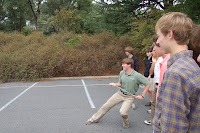Deidre Higgins, of Corbin Kentucky and veteran of my 2009 APSI at Morehead State University, writes:
I was trying to do some lesson planning over the break to get caught up & I was wondering if you could help me with a wave demo. I have in my notes from this summer something about showing interference using paper cups set up two "tiles" away and starting with an amplitude of one "tile," but that's about all I have. (Apparently I need to improve my note-taking skills!) I was wondering if you could give me a brief description of how to do this demo--I remember it being really good to show interference, I just don't remember the details.
Happy to help, Deidre. After I’ve shown the class all the relevant definitions for waves (i.e. amplitude, transverse wave, longitudinal wave, etc.), the class takes a field trip to the tiled floor of the hallway. I bring along a “snakey,” which is like a smaller-diameter slinky with the coils very close together. One student holds an end of the slinky on the floor, while I hold the other on the floor about 5 yards away. The setup is similar to what you see in the picture above, but with the slinky aligned parallel to and on top of a line between tiles. And my kiddies are somewhat older.
I place a line of paper cups on each side of the snakey, parallel to the snakey but about 1.5 tiles away from the snakey’s resting location. I send a wave pulse along the string. If this wave pulse has an amplitude equal to one tile, then the cups aren’t knocked over. (A two-tile-amplitude pulse knocks over all of the cups.)
But when I have the student holding the other end of the snakey send a one-tile-amplitude pulse to me AT THE SAME TIME that I send a pulse to him, the wave pulses interfere in the middle – knocking down just a couple of cups. You see, this is a manifestation of constructive interference. In the middle, the amplitudes of the wave pulses add to form, briefly, a pulse of amplitude two tiles, knocking down the cups.
There’s more you can do with the snakey – move the cups closer and demonstrate DESTRUCTIVE interference, show what a longitudinal wave looks like, show harmonics of standing waves on the snakey, and more. Play with the setup, see what else you and your students are interested in.
GCJ
















